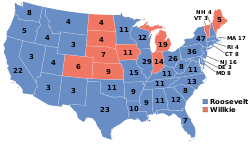| ||||||||||||||||||||||||||
| ||||||||||||||||||||||||||
 County results
| ||||||||||||||||||||||||||
| ||||||||||||||||||||||||||
| Elections in Alabama |
|---|
 |
The 1940 United States presidential election in Alabama took place on November 5, 1940, as part of the 1940 United States presidential election. Alabama voters chose 11 representatives, or electors, to the Electoral College, who voted for president and vice president. In Alabama, voters voted for electors individually instead of as a slate, as in the other states.
Contents
Since the 1890s, Alabama had been effectively a one-party state ruled by the Democratic Party. Disenfranchisement of almost all African-Americans and a large proportion of Poor Whites via poll taxes, literacy tests [1] and informal harassment had essentially eliminated opposition parties outside Unionist Winston County and a few nearby northern hill counties that had been Populist strongholds. [2] The only competitive statewide elections became Democratic Party primaries that were limited by law to white voters. Unlike most other Confederate states, however, soon after black disenfranchisement Alabama's remaining white Republicans made rapid efforts to expel blacks from the state Republican Party. [3] Indeed, under Oscar D. Street, who ironically was appointed state party boss as part of the pro-Taft "black and tan" faction in 1912, [4] the state GOP would permanently turn "lily-white", with the last black delegates from the state at any Republican National Convention serving in 1920. [3]
The 1920 election, aided by isolationism in Appalachia [5] and the whitening of the state GOP, [6] saw the Republicans even exceed forty percent in the House of Representatives races for the 4th, 7th and 10th congressional districts. [5] However, funding issues meant the Republicans would not emulate this achievement for several decades subsequently. [7] Nevertheless, a bitter "civil war" over how best to maintain white supremacy after the Democrats nominated urban, anti-Prohibition Catholic Al Smith saw so many Democrats defect to dry, Protestant Republican Herbert Hoover that he came within seven thousand votes of winning the state. [8]
However, the economic catastrophe of the Great Depression meant that this trend towards the GOP would be short-lived. [9] The Depression had extremely severe effects in the South, which had the highest unemployment rate in the nation, and many Southerners blamed this on the North and on Wall Street. [10] Consequently, the South gave Democratic nominee Franklin D. Roosevelt hefty support in 1932 – he became the only presidential candidate to sweep all of Alabama's counties [11] — and in 1936.
For 1940, opposition amongst Alabama's ruling elite to the New Deal meant that planter and business interests led by former Congressman George Huddleston attempted to organize the "independent elector" movements that would increase after Harry S. Truman's civil rights proposals. [12] Other "Big Mules" already supported Republican nominees, corporate lawyer Wendell Willkie and Senate Minority Leader Charles L. McNary. [13] However, the hatred of the Republican label, in spite of five election cycles as a party exclusive of blacks, [14] meant that the state Democratic Party was far too strong to allow such a revolt. [15]


